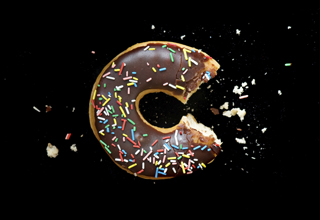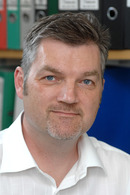Quantum Doughnuts
Interview with Dr Rudolf Roemer, Department of Physics
Published August 2010
 Theoretical physicists, by nature, find themselves working at the very threshold of what is possible. They are closer to mathematicians, really, than the physicists in labs, experimenting. As Dr Roemer, Department of Physics, explains: “I am digging deep, deep, deep into the properties of matter."
Theoretical physicists, by nature, find themselves working at the very threshold of what is possible. They are closer to mathematicians, really, than the physicists in labs, experimenting. As Dr Roemer, Department of Physics, explains: “I am digging deep, deep, deep into the properties of matter."
He has been doing research in the area of quantum mechanics for many years. Quantum mechanics is a branch of physics that provides scientists with a conceptual framework to understand the behaviour of particles at a sub-atomic level. On this scale classical physics models become limited in their capabilities to explain phenomena; quantum mechanics introduced, amongst other things, the notion that some particle properties were restricted to certain amounts or quantities and could not be charted on a continuous scale.
This makes research into quantum mechanics very difficult for the lay person to get their head around. The standard method of understanding new subjects - trying to draw comparisons with topics that are more familiar - is not really an option. The rules of the quantum game are so unlike the picture painted in school science classes. That is not to say it is a recent conceptual shift, quantum mechanics is a well-established methodology, but it does makes life difficult when Dr Roemer is asked what the application of his research is going to be, in the real-world: “There is nothing wrong in asking for impact but the answers are not be based on science - they are based on speculation.”
By investigating matter in this way, they are presented with a real opportunity to discover methods for making matter behave in whole new ways: “We are exploring all the options. We are pushing the boundaries of what is possible. Just because we find that there is a new option that is available does not mean that we will use it, but who knows what problems we will face in the future? If you only research things with immediate applications your options soon run out.”
Research into quantum dots, thanks to a few unintended breakthroughs including the discovery of quantum doughnuts, led Dr Roemer to work out that, theoretically, it was possible to trap light in material, store it in the form of electric charge, and control the release of the light after a set amount of time. In the beginning this effect was a theory only. Experiments have now established that it does happen in reality, but the amount of light is tiny - one photon - and the time it can be stored for is similarly miniscule - in the order of microseconds. This does not bother Dr Roemer however; the gap between this and advanced techniques that will stretch this storage time is much, much smaller than the enormous gulf between the impossible and the possible.
Quantum dots were the result of one particular investigation that aimed to manufacture an environment in which an electron would behave as they do in an atom. When electrons are in an atom they are trapped by their attraction to a positively charged nucleus, this state is defined by a ‘confining potential’. In a quantum dot they are also kept to the same confining potential but there is no central atom creating the constraints - the boundary between the material of the dot and the air creates a physical boundary instead. “It is like trapping an electron in a very small room,” explained Dr Roemer.
Quantum doughnuts are exactly the same but they are ring-like instead of dots - the room is doughnut, not dot, shaped. When light is shined on a quantum dot or doughnut an exciton can be created. An exciton is an electron and the ‘hole’ or absence of an electron that is left behind; the two particles are necessarily created as a pair and are oppositely charged. The structure of the doughnut means that under special conditions the two particles can be held apart, despite the attraction between them. It is this capability that underpins the doughnuts light storing ability.
One photon of light will create one exciton pair in the doughnut. The application of a specific magnetic field enables the pair to be held apart, but the particles are not stationary, they are chasing each other around the ring - “Like a cat chasing its tail”. The size of the exciton pair must be the right fit for the quantum doughnut so that it is just big enough to meet at the other side of the ring when the two particles are pulled apart. When the magnetic field is dropped the pair unite and the light is once again released.
Once Dr Roemer discovered this effect worked in theory, as mentioned above, it was up to the experimental physicists to work out how to make it happen in practice and, more importantly, to deal with the complications of inevitable interaction effects. Dr Roemer’s original theory was based upon 1-d assumptions and so real-life was always going to be more complicated. According to the rules of classical physics this phenomena is totally ridiculous - it breaks so many of them - which highlights again the value of the quantum mechanical conceptual framework.
This technique could be used to take a photo if you happened to have a sheet of quantum donuts, under a magnetic field to hand. You would ‘see’ the photo later when the light, which had been successfully stored, was released: “This would not be a good application these days. We have much better cameras for that.” The more likely use will be in signal transmission. The modern internet uses light to send signals down optical cables and this is a way in which these light signals could be coupled to electronics.
 Dr Roemer is an Associate Professor (Reader) in physics holding a joint position between the Department of Physics and the Centre for Scientific Computing (CSC). He served as Associate Director/Director of CSC from 2005-2010. His research interests include solid state physics, theoretical solid state physics, computational physics, disordered materials, quantum Hall effect, transport problems in quantum systems, meso- and nanoscopic physics, exact solutions, and mathematical physics.
Dr Roemer is an Associate Professor (Reader) in physics holding a joint position between the Department of Physics and the Centre for Scientific Computing (CSC). He served as Associate Director/Director of CSC from 2005-2010. His research interests include solid state physics, theoretical solid state physics, computational physics, disordered materials, quantum Hall effect, transport problems in quantum systems, meso- and nanoscopic physics, exact solutions, and mathematical physics.
